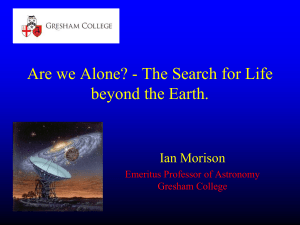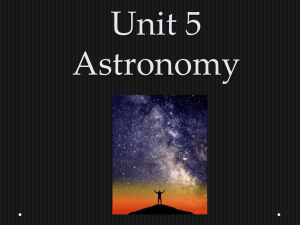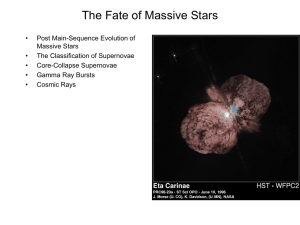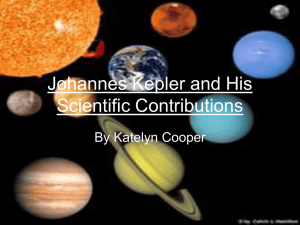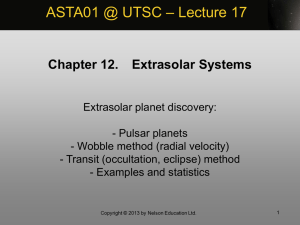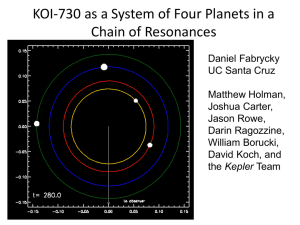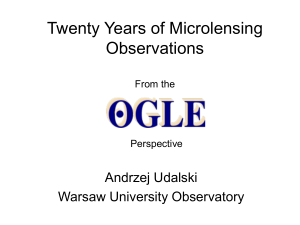powerpoints - Georgia Southern University Astrophysics
advertisement
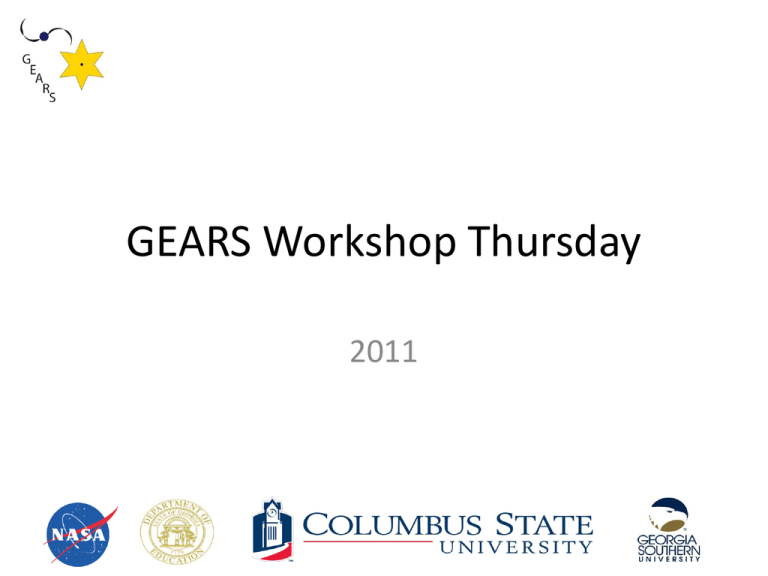
GEARS Workshop Thursday 2011 Warm Up • Howdy! • Please add some more thoughts to paper evals • Please complete your morning warmup Concepts • Astronomers make 3 color diagrams to represent 3 pieces of information visually. For example, 3 different emission line features. • Spectral lines are like fingerprints, they are unique to the element or molecule that emitted (or absorbed) them due to the unique electronic energy levels in each. • Type Ia and Type II supernova remnants may appear similar in size and shape but have different spectral signatures due to the different progenitors. Elements in us • Most of the heavy elements (everything except hydrogen and helium) in the Earth were produced a) by stars that burned out before the Solar System formed. b) in chemical reactions in the primitive oceans and atmosphere. c) in nuclear reactions in the Sun. d) in the hot, dense, early universe. Where do the elements come from? • Big Bang = energy forms neutrons, protons, electrons and overwhelmingly hot and dense conditions are such that Hydrogen (which is only a proton anyway…), Deuterium, and Helium and Lithium nuclei form • http://map.gsfc.nasa.gov/universe/bb_tests_e le.html All other elements • Formed in main sequence stars • Or formed in explosions of stars called supernova (supernovae is plural) • The supernova are needed to spread the fusion products into space – otherwise trapped in stellar cores http://imagine.gsfc.nasa.gov/docs/teachers/elemen ts/ Fusion – summary of chain of reactions – not the exact reaction • Main sequence: 4 (1H) --> 4He + 2 e+ + 2 neutrinos + energy • Hydrogen in core expended – fusion ends, collapse begins, heating and … • 3 (4He) --> 12C + energy (Sun ends here…) • Helium in core expended – fusion ends, collapse begins, heating and … • 12C + 12C --> 24Mg OR 12C + 4H --> 16O E=mc2 • Where does the energy come from ? • Mass of four 1H > Mass of one 4He Low Mass vs High Mass • Really massive stars High Mass Why is Fe so special? • Examining the binding curve in detail. MIT OpenCourseware Formation of the elements • Most of the heavy elements (everything except hydrogen and helium) in the Earth were produced a) by stars that burned out before the Solar System formed. b) in chemical reactions in the primitive oceans and atmosphere. c) in nuclear reactions in the Sun. d) in the hot, dense, early universe. Suppose the universe contained only low-mass stars. Would elements heavier than carbon exist? a. Yes, all stars create heavier elements than carbon when they become a supernova. b. Yes, but there would be far fewer heavier elements because high-mass stars form elements like iron far more prolifically than low-mass stars. c. No, the core temperatures of low-mass stars are too low to fuse other nuclei to carbon, so it would be the heaviest element. d. No, heavy elements created at the cores of low-mass stars would be locked away for billions of years. e. No, fission reactions would break down all elements heavier than carbon. • • • • • Where does Uranium come from? How does the iron get out of the core? Explosions Are all explosions created equally? Explosions leave a mess Mess (nebula) can be swept up into new stars Nebula Tying back to yesterday • We saw S, Si, Mg, O, Fe in the supernova remnants • Tycho – Type Ia (115) • The oxygen-rich supernova G292.0+1.8 contains a pulsar. Type II • Type Ia and Type II remnants because the progenitors are different. Type Ia remnants - from white dwarfs - usually show relatively strong Si, S, Ar, Ca, and Fe, and weak O, Ne, and Mg lines; Type II remnants - from massive stars - generally have the reverse pattern. • (http://chandra.harvard.edu/xray_sources/pulsar_java.html ) • http://chandra.harvard.edu/edu/formal/stellar_ev/story/index.html Core Collapse • http://en.wikipedia.org/wiki/Type_II_superno va • http://hyperphysics.phy-astr.gsu.edu/hbase/astro/snovcn.html Classification • They are classified as Type I if they have no hydrogen lines in their spectra. The subclass type Ia refers to those which have a strong silicon line at 615 nm. They are classified as Ib if they have strong helium lines, and Ic if they do not. Type II supernovae have strong hydrogen lines. These spectral features are illustrated below for specific supernovae. • http://chandra.harvard.edu/edu/formal/snr/bg.html • The elements and their relative abundances are different for Type Ia and Type II remnants because the progenitors are different. Type Ia remnants from white dwarfs - usually show relatively strong Si, S, Ar, Ca, and Fe, and weak O, Ne, and Mg lines; Type II remnants - from massive stars generally have the reverse pattern. In addition to the composition of the ejecta, spectroscopy can show how much of the stellar material was convectively mixed during the supernova event by calculating the density and temperature of the ionizing gas that generates the spectral lines. However, spectroscopy of supernova remnants is not clear cut and drawing conclusions is complicated; it is sometimes difficult to determine if a remnant is Type II or Type Ia. The Chandra and XMM-Newton missions have inaugurated the era of true spatially resolved X-ray spectroscopy. Spectrum on top of Brehmsstrahlung Chandrasekhar limit • The maximum mass that can be supported by electron degeneracy pressure against gravity • Chandrasekhar won Nobel Prize in 1983 with William Fowler • http://nobelprize.org/nobel_prizes/physics/la ureates/1983/chandrasekhar-autobio.html Other parking lot • Related to stellar evolution Switching GEARS • • • • • • Search for extra solar planets This is looking for planets around other stars Not looking for objects orbiting the Sun There is an app for that And the resource for all things planet searchy: http://planetquest.jpl.nasa.gov/ Engage: Demonstration • Take a look at ONE of these ways to represent a star with a planet as seen from a distant observer on Earth • Brainstorm ways to find planets based on this information Engage: Planet demos • Brainstorm how you might detect planets. http://www.youtube.com/watch?v=WApazS6-mu4 Gears@colstate.edu Gears@ColumbusState.edu after May 1 Kepler Mission • • • • Staring at a part of the sky for 3.5 years Watching the brightness of stars Looks for dimming of light from star Periodically! Make some predictions • Think about why you are making your predictions • Spend less than 7 minutes on your predictions Which type of system make it easier to find planets using this technique. If it doesn't matter, write EQUAL CHANCE 1. Less massive stars or more massive stars. 2. Planets with orbits that are closer to circular or highly elliptical orbits. 3. Face-on orbits or edge-on orbits. 4. Small diameter planets or large diameter planets. 5. Small mass planets or large mass planets. 6. Planets close to star or planets far from star. Explore: Transit Simulator • Semi-major axis – average distance from star – see ellipse definition • Eccentricity – ellipticity – or deviation from round – see ellipse definition • Inclination – how much plane of orbit tilts as seen from Earth. Face-on = 0 degrees. Edge on = 90. • Longitude – angle that plane of orbit seen by earth – think 2-D ellipse that you aren’t looking at from short or long axis – but at an angle Discuss • What definition did your group use for easier to find? • % flux change – bigger easier to see • Frequency of dip – must balance between the orbital period (e.g. 100 years vs. 1 year) and the fraction of the orbital period the star is blocked. • Need to discuss normalized flux – 100% of star light seen vs 99%. • Other simulator used 0.1 instead of .99 to represent a 1% drop. After play with sim • Create a hypothesis • Write a hypothesis in the form of "If xxx massive stars make it easier to find planets then I expect to see ________." What is your independent variable? What is your dependent variable? What are your controlled variables? • Hypothesis: If it is easier to find massive planets then I expect to see more massive planets. • Testable with simulator or no? • Discuss Testable hypotheses vs. Good questions to ask. Elaborate: Kepler Flash • Assign multiple people to examine same star to be able to compare answers. • Form to complete for answers. Evaluate: Graphing Kepler Data in Excel Kepler - Period • Multiple ways to decide the period. • Group discussion about what those methods are. Kepler Peer Review • Compare results with other participants who had the same planet. • Provide a formal review of their results on your whiteboard. Kepler Planet - answers The Atlas • http://planetquest.jpl.nasa.gov/atlas/atlas_se arch.cfm?Sort=Star&SorDir=ASC&Planet_Type =Kepl • Sounds like hundreds of new candidates announced at end of May at American Astronomical Society Meeting. Confirmation is after ground based followup – so still only 16 confirmed % difference, % error • Is it appropriate to calculate the percent difference or % error of your results with the astronomically published results in this case? • Discuss in groups. Citizen Science & Kepler data • http://www.planethunters.org/ • Kepler data for your own investigations – published quarterly • A list (in Excel format) of candidates is published (as of Apr 2011) in directory: http://archdev.stsci.edu/pub/kepler/catalogs/ Kepler candidates • Or from link on News page http://archive.stsci.edu/kepler/ • If you visit the html version – you can click on the candidate and plot the light curves from publicly accessible data. (Only the EX – not the STKS) Corrected, Uncorrected Demonstration #2 • Brainstorm some ways to detect planets using this demonstration as inspiration. • Hand out set of demonstrations for each person. Radial velocity • Vs. tangential • Video – introduction • http://planetquest.jpl.nasa.gov/Planet_Finder /planetfinder.html • And Radial velocity • Requires sound Doppler Shift • • • • • Introduction to Doppler shift of light Redshift Blueshift From radial velocity link in Planet Quest video Must use spectral lines – otherwise is just continuous shift to continuous… • http://hyperphysics.phyastr.gsu.edu/hbase/sound/dopp.html#c3 Doppler Shift Lecture Tutorial • Complete this exercise in groups of 2 to 3. • This is designed to be completed while you are discussing with other people. • This is not designed to be completed on your own. Doppler Shift Misconception • Summarize – depending on where are – ABC red, yellow, blue stars – Or spacecraft/planets Habitable Zone • Define it based on your understanding from the simulation • Whiteboard and defend your definition Scientific definitions • Mutually agreed upon by many Habitable zone • Defined as location in a solar system in which a planetary surface could support liquid water • Does not include greenhouse effect heating (like on Earth) • Does not include tidal heating – such as on Europa Why liquid water? • Ties to other disciplines – chemistry, biology Other speculations • What else might be required for life? • Might we find life? • How might we look? Carbon based/Silicon based • How can a discussion of habitable zone be used in biology, chemistry, physics? In 2020, a spacecraft lands on Europa and melts its way through the ice into the Europan ocean. It finds numerous strange, living microbes, along with a few larger organisms that feed on the microbes. a. b. c. d. This is likely because biosignatures were already detected on Europa by the Voyager 2 spacecraft. This could happen because there is evidence for an ocean underneath the icy surface of Europa and water is a good place to look for life. This is fantasy because it would take more than 10 years for a spacecraft to reach Jupiter using current rocket technology. This is fantasy because the X-ray emission from Jupiter has effectively sterilized all the moons around it.
